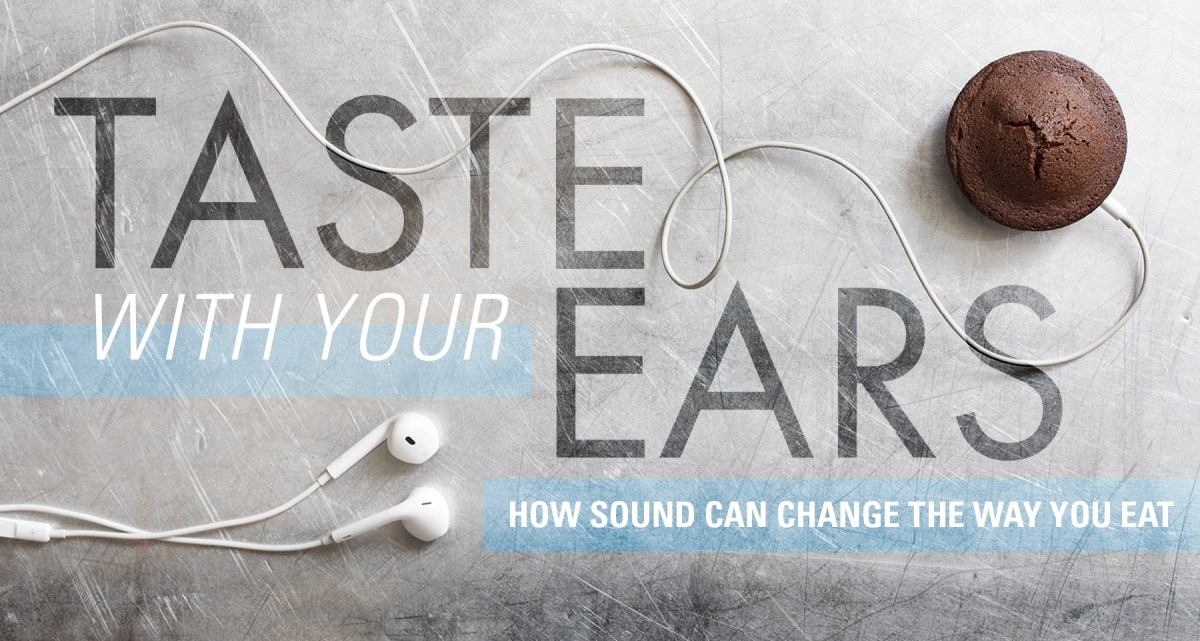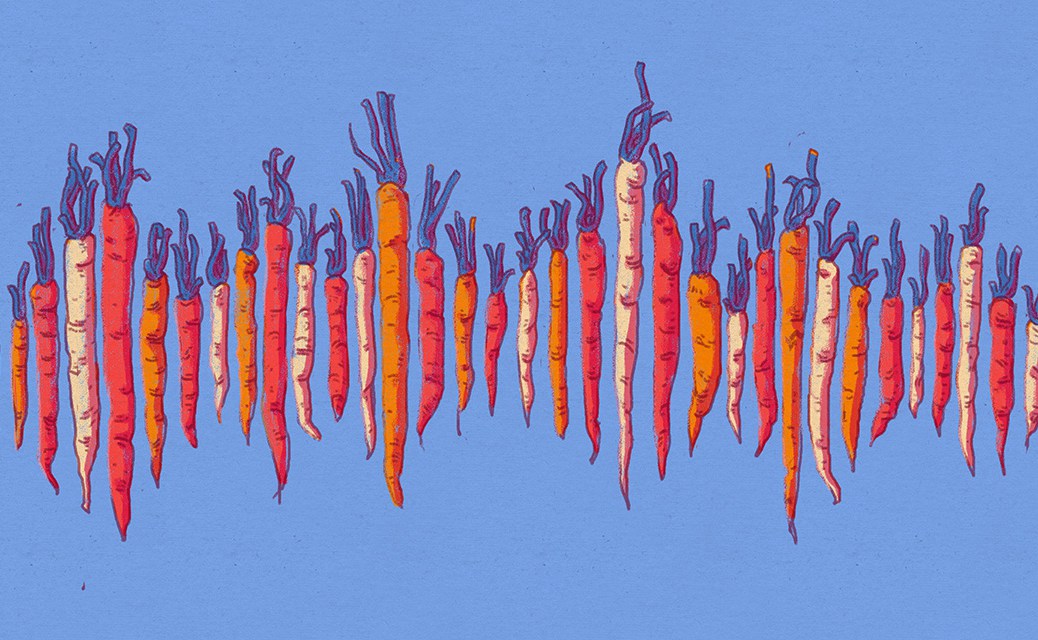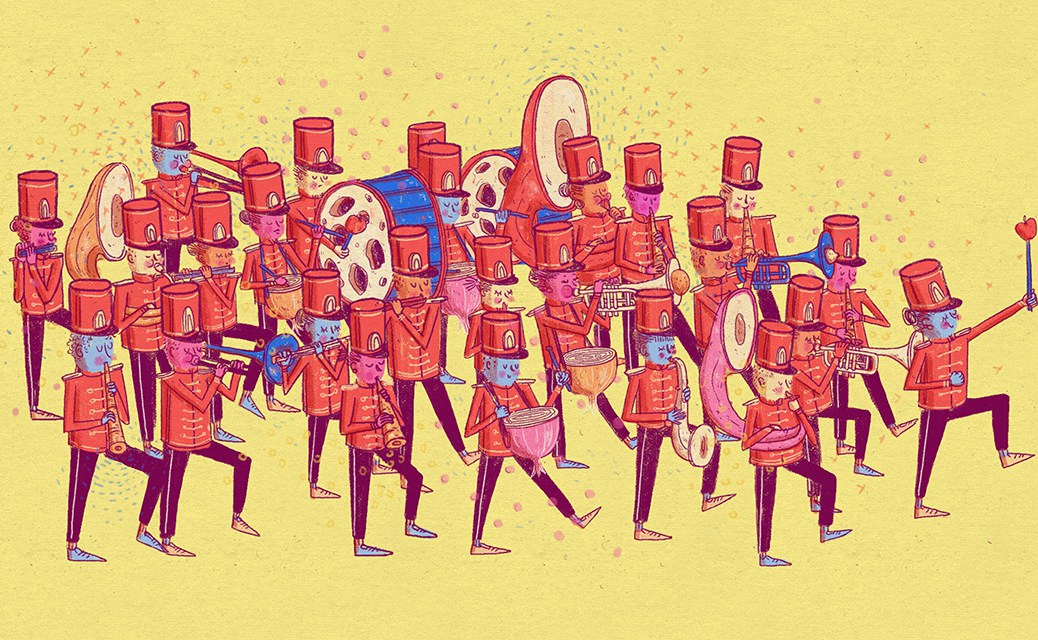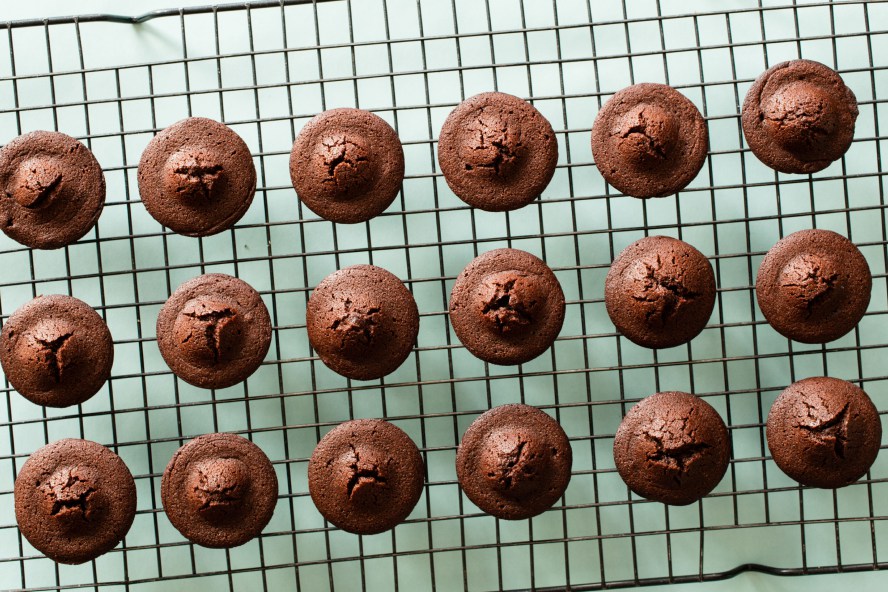Taste with Your Ears

01
In the Restaurant
Whenever Sasha Marx’s mother would visit Parachute, the small Chicago restaurant where he worked as sous chef until last summer, and see him cooking in the open kitchen, she would ask him, “How do you keep track of everything?”
“It’s a combo of visuals and listening,” said Marx. “You’re not watching all things on the stove. So you gain an ear.”
He isolates a moment in his night.
Marx stands at the pass, or the countertop where servers come to pick up finished food for patrons, plating five dishes. He knows that as soon as those dishes are finished, he has to immediately start plating five more. When those are done, there will be five more, an overlapping cycle without a break. The next round will include two steaks, charred Brussels sprouts, and an order of dumplings. His mind is always on the next step.
“You can hear the steaks that you got back in the pan after they rested, to bring them back up to temp. Sizzling over not-too-high heat.”
He’s got a dry cast-iron pan on another burner back there, the temperature jacked up all the way. He’s added Brussels sprouts. “You can hear the Brussels as they are charring; they start to pop up out of the pan. That’s the cue that as soon I’m done plating this one thing in front of me, I’m going to go back and hit them with a little browned butter or lime juice and then get them out of the pan quickly.”
He’s listening to his dumplings as he’s putting together other dishes too. “You know that the water in the steamer basket for the dumplings is getting low because you can hear it boiling. It’s getting down to the bottom of the steamer pot; I’m going to have to add another pitcher of water.”
And the puree that goes under the dumplings? “You can hear by the bubbles that you need to stir it, because it’s popping in the pan like risotto does when it needs more stock.”
“Of course, at the same time you’re communicating with the cook next to you on where you’re at.”
There’s a lot of noise. And that’s the point.
02

How Listening Can Make You a Better Cook
Kathy Gunst, a radio journalist and the resident chef at NPR’s Here and Now, interviewed chef Jacques Pépin for the first time on the radio about ten years ago. She wanted to hear about what he had learned from his many decades in the kitchen. What he said surprised her. Because what he described did not have to do with flavor combinations or ingredient sourcing. It had to do with sound.
Pépin told her he could walk into a kitchen where a young cook was searing a steak and immediately tell if the steak was going to be overcooked. Not by looking. Just by the quality of the sound.
“That woke me up,” said Gunst. “A master chef is so tuned in he can use sound to judge the quality of a young chef.”
Gunst already knew how important sound was when it came to talking about food. She had been cooking on the radio— and talking about cooking on the radio— for many years. And for her listeners, there was nothing to see, nothing to taste, nothing to smell. She had to rely on sound alone to make food seem appealing. She was constantly taking mental notes on what worked and what didn’t. She rarely made pasta on air (too quiet). But she was always interested in the subtle differences between otherwise similar foods. Take the parsnip: The first time she peeled and chopped a raw parsnip on air she was struck by the density of sound it made. It was very different from a carrot—the carrot had more snap.
“Sound is the missing sense when cooking,” she said.
What it comes down to is paying attention—it’s about concentration.
You can hear the sound of a sharp knife verses a dull knife, if you pay attention. You can hear the sound of a steak seared over high heat, the satisfying squish of macaroni and cheese, or the sizzle of cooking bacon. You can hear the moment when popcorn slows its popping, when the lettuce you tear for a salad is crisp-fresh, when the chips from your just-opened potato chip bag are perfectly crunchy. You can hear the difference between champagne, prosecco, and cava; and the satisfying snap of breaking a good chocolate bar in two.
Listening to these sounds, paying attention to them, and learning to recognize and react to them can help you become a better cook. “Because,” said Marx, “when you are thinking actively about what you’re hearing, you start to tie in these auditory cues to what you’re seeing, to what you’re feeling with your hands as you cook, and you start to process all this information. It makes you a more aware cook. And that can only help make you a better cook.”
Some non-Western culinary cultures have sound better incorporated into the cooking experience. Take Chinese cuisine, for example. Grace Young, a chef and cookbook author who was once called the Poet Laureate of the Wok by food historian Betty Fussell, spoke to me about how sound influences wok cooking—stir-frying, especially.
“From the moment you start stir-frying, you have to rely on your senses,” she said. “Not just the visual and the aroma, but the sound.”
“I can tell whether or not a stir-fry will taste correct by the sound,” she continued. “If I was in a room, with my back to the kitchen, I can tell if the stir-fry is being done correctly just by listening. Of course, the cook could be using foul ingredients. But if there isn’t a sizzle sound, it means the wok isn’t correctly heated. The moment you add oil, and then aromatics, there’s this crackle sizzle. If you don’t hear that, something’s off. It’s like a jazz improv. This steady beat of the sizzle throughout the stir-fry. I can tell when a vegetable is being added. There’s a crashing, thunderous sound—very crackly. It’s a different sound than when you’re adding chicken or shrimp or beef. They each have distinct sounds—not so much between the different meats, but the difference between meat and vegetable is tremendous.”
03

How the Sound of Eating Changes How We Taste
Sound is not only important when you’re cooking. It’s also important when you’re eating.
First, let’s back up and talk about flavor.
Though the two terms are often used interchangeably, flavor is different than taste. Taste refers to the five (give or take) sensations perceived by the taste buds on your tongue and in your mouth—salty, sweet, bitter, sour, and umami. Flavor is a term that includes taste—but also incorporates the other senses, including sight (“you eat with your eyes first”) and touch (texture), but especially smell. In fact, it’s often estimated that 80 percent of flavor is made up of scent. (Remember what it’s like when you have a bad winter cold, are all stuffed up, and cannot smell a thing. What does that do to your perception of the flavor of food? It’s likely that most food tastes like cardboard—the flavor is gone.) And sound plays a role as well. Perhaps a larger one than many might suspect.
I recently spoke with Daniel Wesson, currently assistant professor of neurosciences at Case Western Reserve University. Along with his mentor Don Wilson, he worked on experiments designed to show how sound can interplay with your sense of smell—and, thus, flavor—in the brain.
It all started with scent. Wilson and Wesson wanted to understand more about how the olfactory tubercle (a structure at the base of the brain that is involved in odor detection) responds to smell, experimenting with mice. All was going well. They monitored the activity in the mice olfactory tubercles while presenting them with different odors. And then one day during testing, Wesson set down his coffee cup on the counter, clank, and noticed a spike in activity in the tubercle. Did the tubercle also respond to sound? Or was it the combination of smell and sound? Now this was something to dive into.
“[Wilson] and I designed some experiments to simultaneously present sound and smells together,” said Wesson. “That showed interesting things. Imagine. We found that there was a large population of cells in [the] olfactory tubercle that showed activity with smell [about 60 percent]. A subset of those cells showed activity with sound [about 20 percent]. And then a very neat thing: Some neurons represent both sets of information. Here’s a single neuron in your brain that not just says, ‘I smell a smell,’ but also says, potentially, ‘I hear a sound.’ When presented simultaneously (with smell and sound), the activity in that cell is entirely different.”
So what does that mean? Basically, what you hear can change the way your cells process odors. The noise in your environment or in your mouth can impact the scents you perceive. Some members of the media dubbed this connection “smound.”
“When you’re eating food, you’re not just tasting,” said Wesson. “You’re smelling, you’re feeling the texture of food, and you’re hearing the food—either on the plate in front of you or chewing in your mouth. And all of this is going to all come together to change the activity in your brain, to give you the unique perception you know as that food.”
Charles Spence, head of the Crossmodal Research Laboratory at Oxford University in the United Kingdom, has been working on how our senses combine for many years. He’s done a lot of research on how sound affects your perception of flavor. He’s done this with wine and music. He’s done this with chef Heston Blumenthal at the Fat Duck. Most famously, he’s done this with potato chips.
In 2004, for a paper published in the Journal of Sensory Studies, he had his research subjects sit in his lab and eat Pringles potato chips—180 chips each, to be exact (after all: you can’t eat just one). And as each subject ate, Spence and his team altered the crunching-chip sound in their headphones—either deadened to sound like stale chips or amplified to sound like fresh chips.
And what did he find? Those that heard the sound of fresh chips rated the chips they were eating as fresher. Those that heard the sound of stale chips rated the chips that they were eating as staler. But they were all eating the same, crunchy fresh Pringles. Spence and his colleagues have since gone on to test the difference in perception of flavor and sound in many other foods, including sparkling drinks.
“So if you think about the food attributes that we all know and love—crispy, crunchy, crackly, creamy, carbonated, even squeaky—these are attributes of food that initially you think this must be about what we’re feeling in the mouth,” said Spence. “But, in fact, the research shows that they are as much about what we hear in our ears as what we feel in our mouths. And so for that reason I think of sound as the forgotten flavor sense.”
It’s not surprising that crispness is a sound that we appreciate. Evolutionarily it’s associated with freshness—think fresh fruits and vegetables.
The sound of the food in your mouth is not only important for how you perceive flavor, but also for how food companies want you to perceive flavor. “Once you realize just how important the sound is to the overall multisensory experience, you start to understand why it is that the food marketers spend so much of their time trying to accentuate the crispy, crunchy, and crackly sounds in their advertisements,” wrote Spence in the journal Flavour in 2015. “I, for one, am convinced that the chocolate crackling sound is accentuated in the Magnum [ice cream bar] adverts. Obviously, you want to make sure that you get the sensory triggers just right if you happen to be selling 2 billion of these ice creams per year.”
Not everyone thinks about literal sound when it comes to flavor. Todd Maul, bartender at Café ArtScience in Cambridge, Massachusetts, thinks about sound as he builds his drink program in a slightly different way than your average bartender. It’s not just how the drinks taste, or even how they actually sound in your mouth; it’s about the sounds they make you think of as you drink them.
When building a drink, Maul wants each cocktail to contain three “notes”—“three notes build a chord,” he said—a high note, low note, and middle note. This isn’t unfamiliar territory. In the perfume industry, top notes, middle notes, and base notes often refer to the time after applying a perfume that the scents can be perceived. A top note comes fast and quick; a base note is long and lingering, providing depth.
For example, Maul serves a drink called a Reviver, in which he freezes sherry on the bottom of the glass before adding a mixture including gin, sweet vermouth, and clarified lime juice. There’s a low, bitter note in the vermouth, while the sherry is a high note that comes out after it melts from the warmth of your hand holding the drink. “When you’re looking at alcohols, every flavor has a very real note to it. I always tag those notes to music.” Maul thinks of rhum agricole, for example, as a high bright note—“a high C.”
His customers are participating in a song as they drink, continued Maul. “That’s the effect of it for us. There is a beginning, middle, and end.”
04

How the Sound Around Us Changes Flavor
The sound in your mouth (or your mind) is not the only type of sound to affect your perception of flavor. There’s also the noise around you.
Take restaurants. Restaurants can be noisy, drowning out your dinner with the cacophonous chatter of other patrons, of hard thumping music, of simply poorly planned acoustics. Or they can be silent—fancy, quiet, silver-plated theaters devoted solely to the food in front of you. Restaurant reviewers frequently comment on the level and quality of the sound in the spaces they rate. Does it matter? Would the food taste different if it wasn’t so . . . loud. Or . . . so quiet?
Yes.
A 2011 study that appeared in the journal Food Quality and Preference, for example, found that when participants were asked to eat food while listening to either no sound, light sound, or loud white noise, respectively, their perception of taste changed. Reported sweetness and saltiness was significantly less when listening to loud music. Interestingly, the perception of crunchiness was increased when experienced with loud background noise. “This suggests that food properties unrelated to sound (sweetness, saltiness) and those conveyed via auditory channels (crunchiness) are differentially affected by background noise,” wrote lead author A.T. Woods. So don’t be afraid to add a little salt to your food in a restaurant where you can barely hear your dining companion.
Background doesn’t just affect your perception of the flavor of food in restaurants. There have been numerous studies done to show that with loud background noise, the tendency is to consume more. And in a 2012 a study was published in the journal Food Quality and Preference on how background noise changes the perception of alcohol strength. In this study, when loud background noises were combined with a “shadowing technique”—or a distracting task designed to mimic having a conversation in, say, a bar—the ability for participants to evaluate the alcohol strength of a drink was diminished.
Scientists have found another source of loud, continuous noise that affects how your food tastes: airplanes. A paper published in June 2015 in the Journal of Experimental Psychology: Human Perception and Performance simulated the auditory conditions of an airplane trip—playing white noise at more than 85 decibels. They found that the perception of sweetness in participants was lowered with that kind of background noise, but, interestingly, the perception of umami was heightened. (Finally, it makes sense that I love to drink tomato juice on an airplane—tomatoes are high in umami—but rarely, if ever, choose to enjoy it on the ground.)
I asked Spence . . . why? It seems clear that the perception of flavor is influenced by sound, sure, but does anyone have any idea why?
Spence laughed.
“Well, no,” he said. “We know that it happens. You see the papers. Yes, people gravitate toward umami-rich foods on airplanes. But as to why there’s that connection? No one’s got any idea.
“Maybe there’s some direct connection in our brains,” he continued. (Think: smound. Or other parts of our bodies: some scientists have given credit to the vibrations of a nerve in the middle ear.) “Or you can spin evolutionary just-so stories.” Perhaps for animals, Spence said, very loud sounds out on the savanna could be sign of the threat of danger, and under such conditions it might be advantageous to enhance some tastes and decrease others for survival.
Not all noise is created equal. Music also plays a role. In labs, sensory scientists have been able to categorize certain music as sounding “sweet” and other music as sounding “sour” or “bitter.” Sweet music, in general, consists of high-pitched notes while sour or bitter music contains low-pitched notes.
This phenomenon was first reported back in 1968 by Kristian Holt-Hansen, who had participants in his study taste two beers (Carlsberg Elephant lager and regular Carlsberg lager) and then manipulate an auditory pitch simulated on a generator until the pitch matched the flavor of the beer. He found that participants consistently matched the regular, more bitter lager with a lower pitch (510–520 Hz) and the Elephant lager with a higher one (640–670 Hz).
And when played in the background while eating, scientists have found that participants will find food to be sweeter when listening to sweet music and (surprise!) more sour or bitter when listening to the sour/bitter music. In 2011, a study done at the Crossmodal Research Laboratory found that participants rated a piece of toffee as sweeter when listening to music with high-pitched notes and more bitter when listening to music with low-pitched notes. “These results provide the first convincing empirical demonstration that the crossmodal congruency of a background soundtrack can be used to modify the taste (and presumably also flavour) of a foodstuff,” they reported in the study.
Berklee College of Music professor and composer Ben Houge writes music specifically designed to change the way diners perceive the dishes they are eating, including. music to help highlight the sweet flavors, or the sour flavors, of food. He’s also done this with whiskey, and with wine.
He’s also written “food operas,” which played alongside tasting menus in restaurants—a real dinner theater, so to speak. At Bondir restaurant, in Cambridge, Massachusetts, Houge’s food opera involved the sound of chicken farms playing softly in the background of an egg course from individual speakers on each table. “I want people to focus more on what they’re tasting, to pay attention,” he said. “A unique configuration, it can shake people out of habits. In a restaurant I don’t pay attention to music, because I don’t expect it to be related to what I’m eating. I hope my food operas invite people to think along those lines. And to think about the links—interconnected of senses, and people around them.”
05

Back to the Test Kitchen
You don’t need a food opera in order to use sound to become a better cook. Cook’s Science Test Cook Sasha Marx has designed three recipes to inspire you to listen as you cook, and to help you think differently about flavor—and how it changes when the sounds around you change. The following is from his perspective.
When I volunteered for this assignment, I have to admit I was pretty skeptical. It’s all well and good to wax poetic about the beautiful sound of steak sizzling in a hot pan, but developing a series of recipes with a focus on auditory cues was definitely going to be a challenge. I wanted to work with recipes that most home cooks were familiar with, but that they likely never considered through the lens of sound. I also wanted the recipes to be very hands-on in a way that would require cooks to stand by the stove and really pay attention to what was happening at each step. A risotto and a seared steak both fit the bill.
While some find cooking classic risotto to be a tedious chore, I have always found it meditative and soothing. As a kid, I loved helping my mother stir the rice as she would add ladle after ladle of stock, per Marcella Hazan’s strict instructions, listening and watching for the onde (waves) that formed in the pot. When I suggested developing a risotto recipe that would rely on auditory directions, the rest of the team at Cook’s Science was initially doubtful—would there really be anything to hear? I was confident that there would be plenty, however, and secured some recording equipment from our audiovisual department to prove my point. My risotto recording may not win a Grammy, but it turned my coworkers into believers. There is so much to listen for: mushrooms hitting a hot pan, releasing their water, and eventually searing as the water evaporates; onions gently sweating; rice toasting. Then there are the changes in bubble frequency as the simmering stock reduces and the pot goes almost dry—the auditory trigger to add another ladleful. And finally, there’s the iconic lapping waves of risotto all’onda against the sides of the pot—an indication of the proper, loose consistency for serving. Picking up on all these sounds and tying them to steps in the cooking process for my Mushroom Risotto forces focused attention, and just might make for a better pot of risotto.
The Butter-Basted Rib-Eye Steak recipe departs from tradition and might not go over too well with Jacques Pépin. We eschew the classic no-touching approach of only flipping a steak once while cooking and opt for a method championed by Harold McGee and J. Kenji López-Alt that calls instead for flipping the steak frequently. Paired with a butter-basting finale (spooning browned butter and aromatics repeatedly over the steak), this techniques yields an evenly cooked, medium-rare beauty of a rib eye in record time. With only a handful of ingredients and a short cooking time, you really need to pay attention with all your senses—hearing in particular. The sharp, staccato sizzle you hear when a piece of beef hits hot oil in a skillet is the sound of water on the surface of the steak heating to the boiling point, turning to vapor, and escaping the pan into the atmosphere. If you pat a steak dry with paper towels before searing, you’ll hear less sizzle, and if you air-dry a steak uncovered overnight in the refrigerator before searing, you’ll hear even less. That sizzle is also highly dependent on the temperature of your pan, and in this recipe, sound is a good indicator of a properly preheated skillet. If your pan isn’t hot enough, then the sound of the steak hitting its surface will be muffled and gentle when it should be loud and sharp.

The final recipe in this group relates to how sound affects flavor. As mentioned in the article, music can alter the way restaurant diners perceive the flavor of a dish. At their recent Cook’s Science Live: The Burger Tour shows, Dan and Molly ran a little interactive experiment in which they had audience members taste pieces of bittersweet chocolate while listening to two music samples intended to make the chocolate taste either sweeter or more bitter. I decided to take this exercise a delicious step further by developing a superintense bite of chocolate goodness with these Chocolate Financiers. Think of these as a brownie that studied abroad in Paris (don’t worry, you don’t have to listen to any obnoxious stories of eating baguettes outside the Louvre). I amped up the chocolate flavor by using cocoa powder, unsweetened chocolate, and instant espresso powder, and packed it into a bite-sized cake that is crunchy-chewy on the outside, soft and moist at the center. They are sweet. They are bitter. And they are the perfect pairing for composer Ben Houge’s music samples. Bake a batch, toss on some headphones, and hear for yourself how sound can change the way you eat.
Illustrations by Meredith Miotke.
Food Photography by Daniel van Ackere.
Art Direction by Lindsey Chandler.

